Arkadi Monastery is an eastern orthodox monastery located in the southeast of Rethymnon on Crete island, Greece. Arkadi played an important part in the history of Cretan resistance to Ottoman rule during the Cretan revolt of 1866. It became a national sanctuary in honour of the Cretan resistance. According to beliefs, Arkadi Monastery have been founded by a monk named Arcadius. It lies on a rectangular, lush plateau on the northwest side of Mount Ida. The plateau is surrounded by hills, and on the west side, the plateau stops suddenly and falls off into gorges. The place where the monastery is located was first developed in ancient times. What makes it attractive is the presence of Mount Ida, known to Greeks as the childhood home of Zeus.
The interior of Arkadi Monastery resembles a fortress, and it has a total area of 5/200 m2. The island of Crete is known to have the best historical tourist spots in Greece. One of them is the Arkadi Monastery. Tourists can go and visit the monastery every day between 9 am to 8 pm. There is public transportation like buses and taxis going to the monastery, but Car Rental Crete is quite prominent. Adventure seekers can also enjoy the beautiful hiking trails of the famous Arkadi Monastery. Available tour buses are going to the monastery and tourists can make their bookings before visiting the monastery. There are available routes open for hikers to enjoy. Tourists rent a car to fully enjoy and discover the monastery within their choice of time. Car rental is a more flexible and convenient way to tour the historical monastery. The journey takes no more than 40 minutes. The roads are not difficult and the best way to enjoy the beautiful mountain landscape is by driving a rented car.
What happened in Arkadi during the Cretan Revolt?
On Thursday, November 8, 1866, approximately 964 Cretans, including fighters, women, and children, sought refuge in the monastery as it was besieged by a large Ottoman force. The Cretans, led by Konstantinos Giamboudakis, resisted fiercely. When it became clear that defeat was imminent, the defenders chose to ignite the gunpowder stored in the monastery, resulting in a massive explosion that killed many Cretans and Ottomans alike. This act of self-sacrifice became a powerful symbol of resistance and drew international attention to the Cretan struggle for independence
The event drew international attention to the Cretan struggle for independence and became a symbol of resistance and heroism. Although the Ottomans continued to rule Crete for several more decades, the sacrifice at Arkadi Monastery played a crucial role in garnering support for Cretan independence, which was eventually achieved in 1913. The monastery stands as a national monument and a poignant reminder of the resilience and courage of the Cretan people.
What is the history of Arkadi Monastery?
The Arkadi Monastery, located on the island of Crete, holds a significant place in both religious and national history due to its role in the Cretan resistance against Ottoman rule. Founding and Early History The exact date of the monastery’s founding is uncertain. Some traditions attribute its establishment to the Byzantine emperor Arcadius in the 5th century, while others suggest it was founded by a monk named Arkadios in the 11th century.
The current church, or catholicon, was constructed in 1587 and showcases Renaissance architectural influences, blending Roman and baroque styles. Throughout its history, the Arkadi Monastery was a center of education and culture. In the 16th century, it housed a school and a rich library, and it became known for manuscript copying and gold embroidery workshops in the 17th and 18th centuries. These activities contributed to the monastery’s economic and cultural wealth. The 1866 Siege and Holocaust The most defining event in the monastery’s history occurred during the Cretan revolt against Ottoman rule in 1866.
The monastery became a refuge for 964 Cretans, including fighters, women, and children, as they sought to resist the Ottoman forces. On November 8, 1866, the monastery was besieged by approximately 15,000 Ottoman soldiers equipped with cannons. Despite fierce resistance, the defenders ran out of ammunition and were forced to resort to desperate measures.
Under the leadership of the abbot Gabriel Marinakis, the Cretans decided to ignite the gunpowder stored in the monastery, resulting in a massive explosion that killed many of the defenders and attackers. This act of self-sacrifice became a powerful symbol of resistance and drew international attention to the Cretan struggle for independence. Legacy and Commemoration
The Arkadi Monastery is now a national sanctuary and a symbol of Cretan resistance. November 8 is commemorated annually to honor the events of 1866, with ceremonies held at the monastery and in Rethymno. The monastery also houses a museum that displays historical relics, including the Sacred Banner of the rebellion, and serves as a pilgrimage site for many visitors. The Arkadi Monastery’s story of heroism and sacrifice has left a lasting impact on Greek history and continues to inspire those who visit this historic site.
What is the Arkadi Monastery Museum?
The Arkadi Monastery Museum is a significant cultural and historical site that offers a deep insight into the monastery’s heritage and role in Greek history. Housed in the southwestern part of the monastery, it includes monastic cells and auxiliary rooms. The museum showcases a diverse collection of artifacts, including post-Byzantine icons, ecclesiastical vestments, implements, weapons, manuscripts, and personal items from the abbot and other historical figures.
The museum also features an art gallery established in 2016 to commemorate the 150th anniversary of the Arkadi Monastery’s self-sacrifice in 1866. Located on the first floor, the gallery displays works inspired by the monastery’s history, including notable paintings by Popi Pavlakis, donated by the Municipality of Rethymno and the Crete Museum of Modern Art.
Visitors can benefit from interactive IT navigation systems providing additional information about the monastery’s history and significance. The museum and art gallery together offer a comprehensive view of the monastery’s spiritual, cultural, and historical journey, making it a must-visit for those interested in Cretan and Greek history.
What can people see in Arkadi Monastery Museum?
The Arkadi Monastery Museum in Crete houses a remarkable collection of ecclesiastical and historical artifacts that reflect the rich cultural and spiritual heritage of the monastery. Among the most famous artworks are post-Byzantine icons, known for their intricate craftsmanship and religious significance. These icons, along with ecclesiastical vestments and implements, provide insight into the religious practices and artistic traditions of the period.
One standout exhibit is the banner from the Arkadi Holocaust, depicting the Transfiguration of Christ. This banner symbolizes the monastery’s role in the Cretan resistance against Ottoman rule and holds a place of honor in the museum. Another unique piece is a section of the carved altar screen from the church, depicting the Resurrection, the only piece that survived the explosion and fire during the 1866 siege. The museum also features a collection of sacerdotal vestments, including a particularly outstanding piece with gold embroidery from 1681, depicting Christ and the twelve disciples. These vestments highlight the monastery’s importance as an embroidery center during the 17th century.
In addition to religious artifacts, the museum displays weapons used during the struggle against the Ottomans, such as flintlock rifles, long-barreled pistols, and Ottoman firearms like the Turkish musket. These weapons, some named after benefactors who supported the Cretan rebels, illustrate the monastery’s pivotal role in the fight for independence. The art gallery within the museum, established in 2016 to commemorate the 150th anniversary of the Arkadi Monastery’s self-sacrifice, features works by past and contemporary artists inspired by the monastery’s history.
Notable among these are paintings by Popi Pavlakis, donated by the Municipality of Rethymno and the Crete Museum of Modern Art. These artworks, along with others donated by individuals, contribute to a deeper understanding of the monastery’s historical and spiritual journey.
Where is Arkadi Monastery located?
The Arkadi Monastery is located in Rethymno, Crete, Greece. It is perched on a hilltop plateau 22 km to the southeast of Rethymnon, surrounded by olive groves, and vineyards. The church furthermore has two naves; the left side dedicated to the Transfiguration, and the right side to Constantine and Helena.
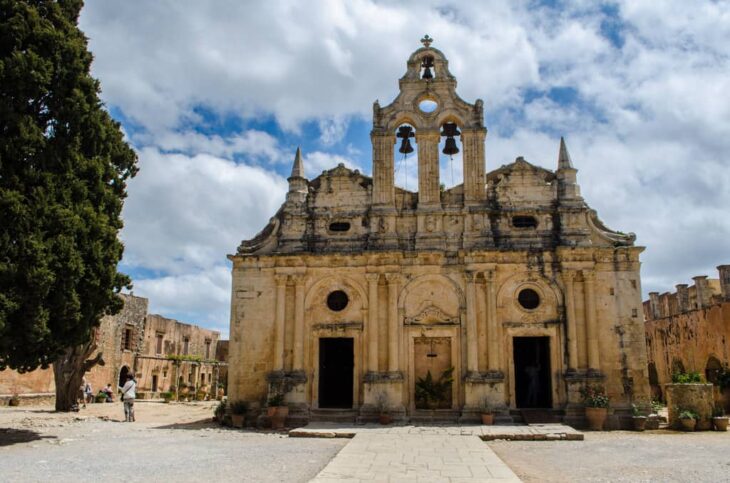
What to know before going to Arkadi Monastery?
Before visiting the Arkadi Monastery in Crete, it’s important to be aware of several key details to ensure a fulfilling and respectful experience. The monastery is open daily, with varying hours depending on the season: from 9:00 AM to 7:00 PM in April and May, extending to 8:00 PM in the summer months of June through August, and closing earlier at 5:00 PM in November. The admission fee is €4 per person, though Greeks can enter for free as it is considered a pilgrimage site.
Visitors should dress modestly to respect the religious and cultural significance of the site, typically covering shoulders and knees. While the dress code is not as strict as in some other monasteries, it is advisable to avoid sleeveless tops and shorts. The monastery is located 22 km southeast of Rethymno, set amidst the scenic hills and gorges of the Amari Valley. It can be reached by car, bus, or even e-bike from Rethymno, with ample parking available outside the grounds and a nearby taverna for refreshments.
The monastery complex includes several notable attractions such as the Main Church (Catholic), Historic Dining Room, Cellars, Powder Keg, Museum, and Art Gallery. Significant sites within the monastery include the church facade designed by Italian architects Sebastiano Serlio and Andrea Palladio, the reconstructed western doors, the morgue containing remains of fallen defenders from the 1866 siege, and a dead tree that still bears a bullet from the attack.
The monastery celebrates three major holidays: May 21, dedicated to St. Constantine and St. Helen; August 6, dedicated to the Transfiguration of Christ the Savior; and November 8, which commemorates the Holocaust of the Sacred Monastery of Arkadi in 1866. Facilities include toilets in the car park and a snack bar (Arkadi Café) nearby. Photography is generally not allowed inside the church and museum.
To avoid the heat and crowds, it’s best to visit in the early morning or late afternoon. During the summer, the monastery can get quite busy with tourist coaches. Consider taking a guided tour to fully appreciate the historical and cultural context of the monastery. By keeping these points in mind, you can ensure a respectful and enriching visit to the Arkadi Monastery, a site of profound historical and cultural significance.
Is there a dressing code to visit Arkadi Monastery?
Visitors are required to cover their shoulders and ensure their legs are covered above the knees, meaning sleeveless tops and short shorts are not appropriate. The dress code is not overly strict but maintaining a respectful clothing is required to honour the sacred site. Modest dress code helps preserve the monastery’s dignity as both a functioning religious institution and a historical landmark.
What is the visiting hours and admission of Arkadi site?
The opening hours of Arkadi monastery is open daily with varying hours depending on the season. Find them below.
- April – May: 09:00 to 19:00
- June – August: 09:00 to 20:00
- September: 09:00 to 19:00
- October: 09:00 to 18:00
- November: 09:00 to 17:00
- March: 09:00 to 18:00
The entrance fee is €4 per person and both cash and cards are accepted. Greeks may enter for free as it is considered a pilgrimage site.
Is Arkadi Monastery safe?
Yes, Arkadi Monastery is definitely safe to visit. There are local guards always on duty inside the monastery. Tourists can enjoy their walk within the area without fearing for their safety. It is a monastery, so the place is expected to be quiet and tranquil.
What is the best season for visiting Arkadi Monastery?
The best season to visit the Arkadi Monastery is during the shoulder season, between the months of April to June, and September to October. However, there are tourists who enjoy the pleasant weather of Crete throughout the year. Summer can get quite hot and crowded. The low season of November to March has fewer crowds but has high chances of rain.
What is the best way to visit Arkadi Monastery?
There is available local bus transportation in Arkadi Monastery, but renting a private car is the best vehicle for visiting the monastery. Tourists can go to many beautiful spots on their own using a rented car. Just make sure to always check the requirements for renting a car.
Can you rent a car to go to Arkadi Monastery?
Yes, you can rent a car to go to the Arkadi Monastery. While there are available public buses on the road, it is recommended to rent a car, especially for tourists. Renting a car in Crete will give tourists the freedom and flexibility to travel on their own.
What are the factors to consider before renting a car in Crete?
Listed below are the factors to consider before renting a car in Crete.
- Insurance. Insurance is important when renting a car in Crete. It includes insurance for Collision Damage waiver, and a credit or debit card driver is required as a guarantee. Car rental insurance protects a passenger against the cost of damage that may happen when renting a vehicle.
- Driver’s age. Aside from a valid licence, age is one of the factors to consider when renting a car. In Crete, the legal age needed for a car rental driver is between 21 years old. A driving licence is also required.
- Driver’s gender. As long as the driver is of the legal age of 18, driving regardless of gender is allowed in Crete. While some may prefer male drivers, a female can drive and rent a car in Crete.
- Car type. Opting for a smaller car is best when driving in Crete. The main reason is that Greek roads are narrow. There are noticeable smaller cars on the roads too.
- Documents needed for renting a car. Most people think that the only document needed for renting a car is a driving licence. However, that is not the case. Most car rental companies in Crete require a credit or debit card with the driver’s name on it.
How much does a car rental in Crete cost?
The car rental cost in Crete varies depending on the location, the number of passengers, itinerary, car type, and duration. The average cost of renting a car in Crete is around €30 to €40 per day. Renting a car for a whole week will cost on average €250 while renting for the weekend will cost around €78. Affordable Crete car rental varies depending on the car type.
What is the contribution of Arkadi Monastery to Crete Tourism?
Tourism is one of the blossoming industries in Greece. A total of 4.55 million international tourists visited Greece between January and July 2021. The island of Crete in Greece is known for its spectacular tourist destinations. Crete has been voted one of Europe’s top 5 tourist destinations. In total, more than four million tourists visit Crete every year. Arkadi Monastery is one of the most famous monasteries in Crete. It is considered to be Crete’s national sanctuary. Tourists who are interested in religion and culture will perfectly love the historical value of the monastery.
What are the nearest attractions to Arkadi Monastery?
Listed below are the nearest attractions to Arkadi Monastery.
- Kavoussi. Kavoussi is a settlement in Arkadi in Rethymno in Crete. It is a known archaeological site in eastern Crete. It is built at the foot of two imposing mountains. Kavoussi is a historical and lively village that offers many activities and gorgeous sights. Kavoussi is one of the most interesting villages in Lerapeta.
- Kyrianna. Listed also as a traditional settlement and a municipal district is the village of Kyrianna. Kyrianna has a very beautiful old church inside the village that is worth visiting. The architecture is similar to the Arkadi Monastery church and every corner is beautiful.
- Amnatos. Amnatos is located on the northeastern edge of the Gargano mountain. It is a local community of the Rethymno Municipality in the region of Crete. It has buildings with Venetian architectural elements, and it was awarded as the “Cleaner and Organised Traditional Community”.
- Kapsaliana Village Hotel. Kapsaliana is located in Rethymnon. It is within a 10-minute drive of Arkadi Monastery. It was a 16th-century village on Crete that was transformed into a world-class hotel. Kapsaliana was part of the Arkadi Monastery estate, the island’s most emblematic monastery.
- Kournas Lake. Kournas Lake is known to be the only freshwater lake in Crete. It was known as Lake Koressia, but later took its current name from an Arabic word meaning lake. It is located in beautiful scenery, lying in a valley among the hills. Kournas lake is about 4 km from Georgioupolis in Chania Prefecture. The lake is quite small, with a length of 1,087 m and a maximum breadth of 880 m. Kournas lake business is open every day. It is generally shallow, with only 22.5 m at its deepest point. Although, it is a nice place to visit all year round. The best time to visit Kournas Lake is during summer, an ideal place to enjoy summer days on its river banks.
- Spili. Spili is an ideal destination for visitors and locals, whenever they are spending their holiday in Crete. It has an altitude of 430 m, at the foot of Mount Vorizis, and is an offshoot of Kedros Mount. Furthermore, it is a perfect destination for tourists because almost all basic services can be found in Spili. One need not worry about accessing basic needs. Spili is a convenient place. There are banks, health centres, a police station, taverns, and even the Church Conference Centre. The best time to visit and enjoy Spili is during spring or fall. There are fewer people during those times, compared to the summer months when it is peak season.
- Rethymno city: Rethymno is located at the north end of the prefecture, on the western side of Crete. It was once called Rithymna. The town was greatly influenced by the Venetians, and it has elegant architecture and a scenic port. Rethymno is full of archaeological sites, quaint villages, lovely beaches, and Byzantine churches. The best time to visit Rethymno is during summer. The lovely beaches will be perfect for visitors who love swimming and sunbathing in the sun. Rethymno is also a popular carnival destination in Greece.
Why is Arkadi Monastery considered archaeological sites?
Arkadi Monastery is considered an archaeological site because of its historical significance. The monastery played an important part in the Cretan resistance to the Ottoman during the Cretan revolt of 1866. One of the bloodiest events in Greek history took place at the Arkadi Monastery. During those times, many Cretans felt they were being mismanaged and were asking for an improved tax system, respect for Christian religion, the right to elect elders, and steps for the development of the island. They were asking for help to act for the unification of Crete with Greece. The Cretans decided to stand up on their own and raise a flag with the slogan “Union or Death’, on August 21, 1866. The Turkish leader demanded a surrender at the monastery walls, but the Cretans responded with gun fire. The Cretans sacrificed themselves, blowing up barrels of gunpowder. The explosion also killed more than 1,500 Ottoman soldiers. Cretans refused to surrender, thus sacrificing their lives.
Last updated on .








